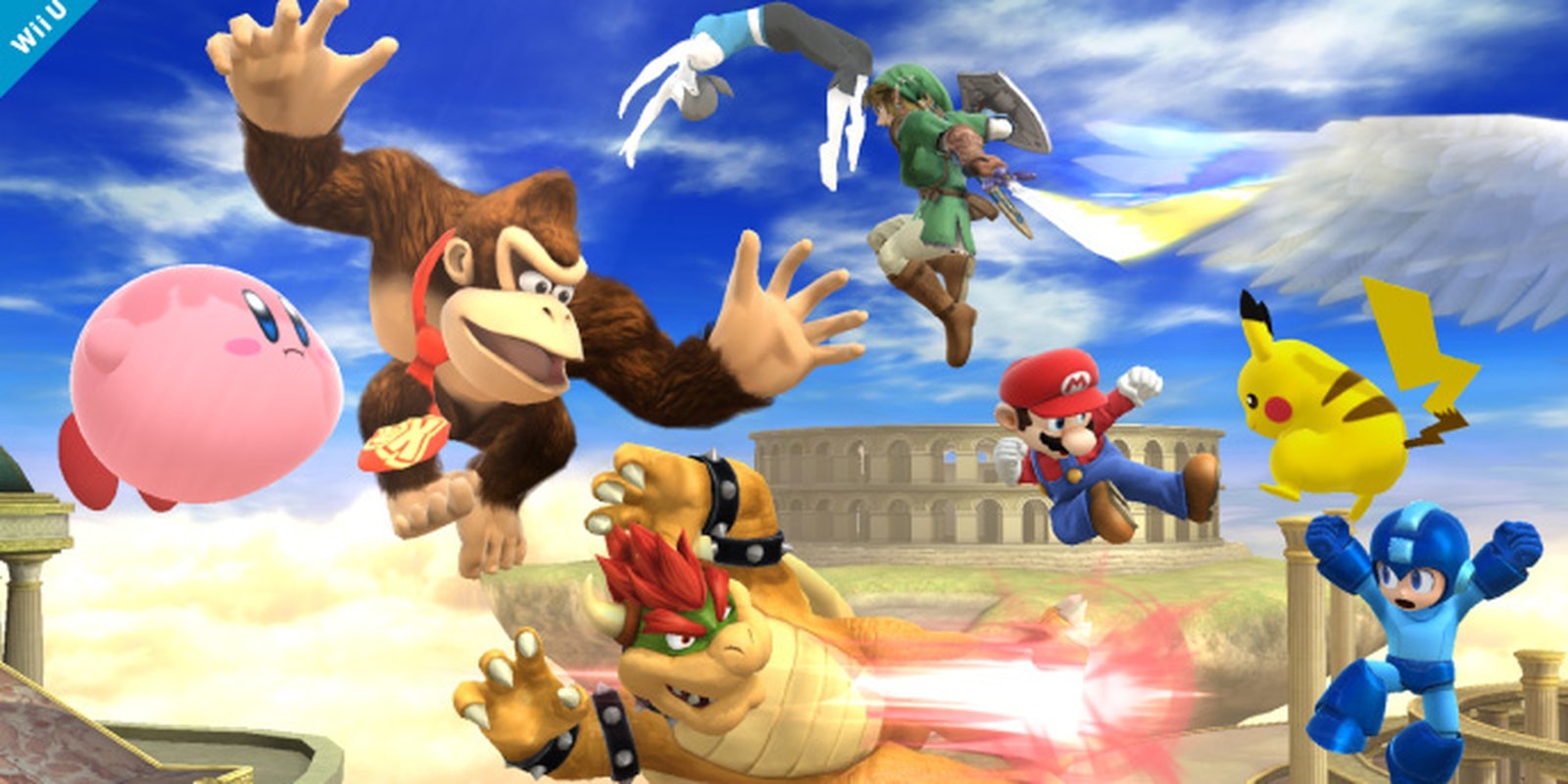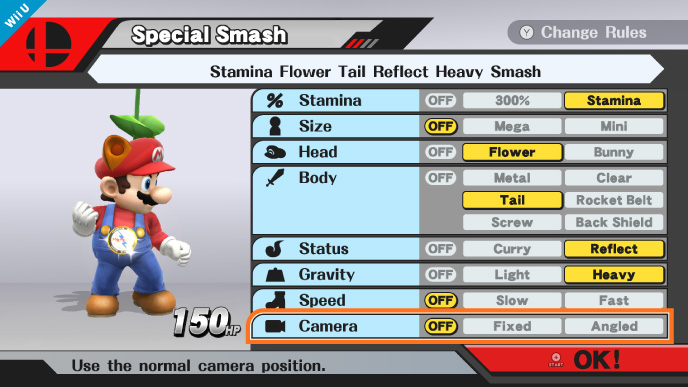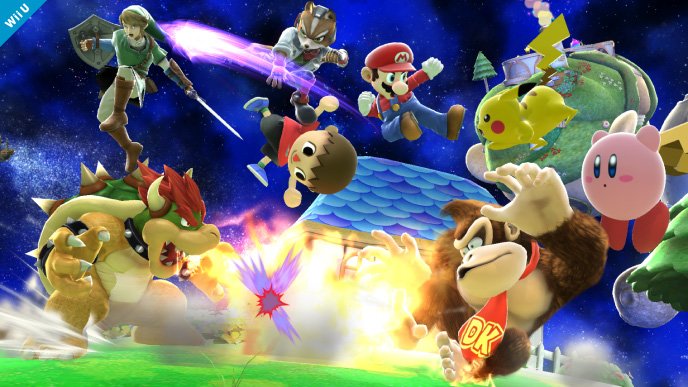BY SCOTT NICHOLS
Let’s get right to the point: Super Smash Bros. for Wii U is by far the best game in Nintendo’s mascot brawler series to date. This is an especially impressive achievement because most of the standout new features on Wii U consist of half-hearted attempts and missed potential.
Yes, Super Smash Bros. for Wii U is not all smiles and rainbow roads, but that won’t stop it from becoming the new benchmark for the series, and holding claim to being one of the best reasons to own a Wii U.
Little has changed in the core gameplay from past Smash Bros. iterations. You choose your fighter from a massive roster of 51 characters—assuming you count the three Mii fighting styles as separate characters (which you should). Players already familiar with the new roster from the 3DS version will be happy to find that more characters are available from the start, with only a small handful hidden away until you have completed certain challenges or criteria.
New to the roster on Wii U, as well as 3DS, is the ability to customize each character’s moves. Like in past games, characters have four special attacks performed by the B button in conjunction with a direction. Well, for this iteration of Smash Bros, Nintendo is providing three options for each of the four special attack slots. These alternate moves can range from slight variations to a familiar attack to giving a fighter completely new functionality.
For example, Mario can replace his regular up special attack with a slightly shorter jump with a fiery explosion at the end to deal more damage and launch enemies farther if it connects. It’s still essentially the same move, but with slightly different tactical uses. On the other hand, newcomer character Palutena’s alternate moves include the option to replace a defensive shield that pushes nearby fighters away with a powerful attack, ramming into a foe like a missile.
Of course, players who want to maintain the purity of each fighter’s default move set can turn off customized characters in matches, and to keep online matches even the only customized characters you can use there are the Mii fighters. But customizing a fighter’s moves can also make the difference between hating and loving playing as a character, making it a fantastic addition to the series.
In another first for the series, Super Smash Bros. for Wii U lets up to eight players fight at once. This was not an easy thing to accomplish, My friends and I didn’t have access to the Gamecube controller adapter and the game seemed to have trouble syncing more than four Wii remotes or Wii U pro controllers at a time, even though the Wii U is supposed to support up to seven. After some effort though we managed to gather a combination of controllers and 3DS systems that allowed for the full suite of eight players. A special note: Using the 3DS as a controller works surprisingly well, with no noticeable input lag over any other controller.
Having eight players in Super Smash Bros. is about as chaotic as it sounds, but it is also immensely fun. Splitting up into teams helps to alleviate the chaos, or you can set all eight players to Captain Falcon and choose a tiny level like Yoshi’s Island to fully embrace the over-crowded absurdity of it all.
If there is a downside to having eight players, it is the level selection. Or more accurately, the lack of levels available. Less than half of the levels are available in eight-player mode, and the ones that are available seem rather arbitrarily selected.
Some levels were obviously made for the higher player count, like Palutena’s Temple and The Great Cave Offensive. But even with a full roster, these levels seem excessively large, to the point where I wondered if Nintendo originally planned to have more zone-based game variants like capture the flag or king of the hill but scrapped those modes before releasing the game.
There are also a handful of comically tiny levels available to eight players, like the aforementioned Yoshi’s Island. However, most of the mid-sized levels that would be a perfect fit for five to eight players are greyed out at the level selection screen. The Punch-Out arena and new Kalos Pokemon League stages? Nope, four players only. Or how about the new Jungle Hijinx level, which features both playable foreground and background areas that occasionally disappear and force a fight into a temporarily condensed brawl. It’s probably the best new level in the game, and a baffling missed opportunity since it would introduce ways for eight people to play together that are far more interesting than simply adding more real estate to a level.
The problem is compounded because in order to play with any number of players higher than four you need to select the eight-player mode. So even if you have five or six players that might fit better on a mid-sized level, if the game arbitrarily greyed out that map for the eight-player mode then you’re out of luck.
Another Wii U exclusive new mode is Smash Tour, replacing the 3DS version’s Smash Run mode, and unfortunately it is the weakest part of the entire game.
The premise for Smash Tour is essentially a board game, with up to four players parading around the board collecting stat bonuses and a stable of fighters to use in a final confrontation to determine the winner. Each turn, all four players will roll a spinner and then move simultaneously, which keeps the game moving at a quick pace. And if two players collide on the board it initiates a battle where the victor has a chance of stealing a fighter from one of the losers.
It is an idea that sounds fantastic on paper, and if implemented well Smash Tour had the potential to compete on equal footing with Nintendo’s Mario Party series.
The immediate issue I encountered with friends is the inability to use player profiles with customized controls in Smash Tour. So if you don’t like pressing up to jump or prefer to play with the shield and grab buttons swapped then you’re out of luck, and that can be an immediate turn-off for some players. It is especially baffling since there is no reason why the game couldn’t allow players to select a profile while selecting their Mii avatar for the board game.
For the hardcore Smash Bros. fan, the board game itself is too shallow to remain engaging, and the reward for winning the infrequent smaller fights isn’t consistent enough to be worth the effort. Sometimes you’ll steal a fighter from an opponent, but sometimes you will just win a small item to use for a slight advantage on the board or in the next match. Every player receives a random new item every turn though, so that one extra item isn’t really much of an incentive.
Meanwhile, more casual players will find Smash Tour too intimidating. The aforementioned items have a wide range of effects and very specific short windows of time to be used, which immediately bogs down Smash Tour in far too many rules to make it accessible for first-time players. There is also the fact that the fighters you collect are essentially random, and make liberal use of the game’s customizable moves, so players who aren’t already familiar with every facet of every character are at a disadvantage.
After playing a few rounds of Smash Tour, the unanimous consensus among my friends was that it just made them want to play the regular fighting modes more and never touch Smash Tour again—a request I was only too happy to accommodate.
Thankfully, the fighting game core of Super Smash Bros. for Wii U absolutely delivers. Series staples like the classic arcade mode, home run contests, multi-man melees, target tests, and All-Star Mode’s gauntlet of fighting every character in succession return as well, and every one of those can be played either solo or as a co-op team with one friend. Target test is the most changed of those from past entries in the series, ditching the skill-based obstacle courses of old for something much closer to Angry Birds as you launch a bomb toward an array of targets. It’s a change in line with the current trends in gaming, but it also feels a bit redundant since it plays so similarly to home run contests.
The event mode makes up for the changes to target test, providing an ever-expanding map of challenges using characters in specific scenarios. The events are both a fun challenge and occasionally instructive, teaching you to use a familiar character in a new ways.
And if you manage to run out of events from both the solo and co-op modes, each with their own uniquely designed challenges, there is also a new mode called Special Orders. Special Orders offers you an infinite supply of random events, rewarding you with trophies to collect, new songs for the game’s massive soundtrack, and items for customizing your fighters.
And then there are the amiibo figures, which join Smash Tour as a potentially interesting idea that doesn’t feel fleshed out. Tapping an amiibo to the Wii U Gamepad imports and A.I. controlled version of that character, allowing you to customize its moves and fight against it for training. The amiibo character levels up as you beat it in matches, so it can work as a training tool by pushing you to improve until you can’t beat it anymore, but you could already replicate most of that experience by setting the difficulty level of regular A.I. opponents.
You can also bring your amiibo and its custom fighter to a friend’s house to use on their Wii U, but it’s still just an A.I. fighter rather than the ability to transfer a customized character that you can actually play as against your friend. Even with amiibos and two of the game’s prominent new modes falling short of their potential, there is still no shortage of genuinely fun diversions to keep you coming back for more Smash Bros.
Speaking of falling short of its potential, there is one more feature in Super Smash Bros. for Wii U that needs mentioning: Its online capabilities.
Nintendo has never had a particularly strong reputation when it comes to playing online, and Super Smash Bros. for Wii U is no exception. About half of the time playing online was a relatively seamless experience, with For Fun and For Glory modes letting me choose to play with items and level hazards or without. The other half of the time though, the lag can get so bad that the match turned into a slide show. In multiple matches the screen would freeze for as long as 20 seconds or more while trying to maintain a connection, making the game unplayable. Hopefully Nintendo can get its online act together by the time online tournaments are eventually introduced, but to call the online experience a rocky start would be a severe understatement.
Super Smash Bros. for Wii U is a bit of a flawed masterpiece. The core fighting game is the best it has ever been, expertly balancing approachability for newcomers and intricate depth for hardcore fans. If the core Smash Bros. experience is all you are after, then the Wii U’s iteration is a no-brainer.
However, that fantastic core is surrounded by a lot of extraneous bloat, the most prominent of those new modes feeling under-developed and arbitrarily limited. Super Smash Bros. for Wii U is bizarrely inconsistent when it comes to the quality of the total package, but at least it hits all of the right notes where it counts.
Photo via Nintendo





